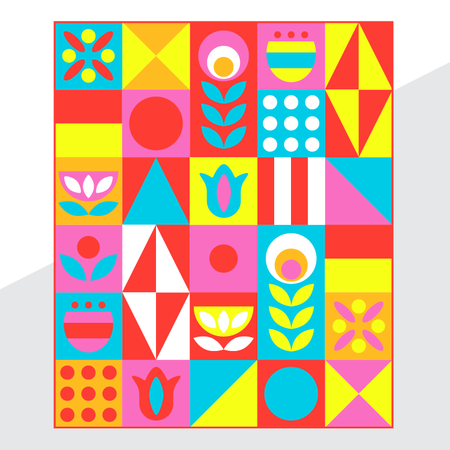Easy Ways to Applique
~
Overcome Your Fear of Appliqué!
I’m always a little surprised that quilters are so afraid to go near appliqué. I’m hoping with the right tips and tricks I can bring more people over to the appliqué side! I was tempted by appliqué early on in my quilting journey. I am a person who needs to know how to do every method, will try them all, and then decide what I like the best and I encourage you to do the same! We all have different preferences, so it can be really useful to try different things out to see what gives you the best results, and doesn’t cause you to tear your hair out.
This week I’m going to go over three different turned edge appliqué methods: Glue-baste appliqué with water soluble paper, heavy-duty freezer paper appliqué, and finally mylar template plastic appliqué. As a bonus, I’ll also be sharing a post about perfect circle appliqué, made famous by the great Karen Kay Buckley. You’ll notice I’m not covering raw edge appliqué. Speaking of methods that hurt our brains, that is mine. I just have a really hard time getting on board with raw edges and have yet to find a raw edge technique I like as much as turned edge. There are a ton of folks out there who do it well, I am not one of them so I’ll be sharing the techniques I am proficient at versus those I’m not.

I wanted to at least provide you with a fun project you could make while exploring the different appliqué techniques. I designed a small butterfly block that lets you try out each method and end up with a cute little quilt block. You can download the template file below.
Butterfly Applique Project Template File Download
It can be quite an investment to purchase all of the different papers/mylar I use in the upcoming tutorials, so for a limited time I’m selling small sampler packs in my shop. Each pack has one sheet of water soluble appliqué paper, one sheet of heavy-duty freezer paper, and one half-sheet of mylar template plastic. You can purchase the sample pack here until they run out!
Appliqué Sample Pack
Let’s take a quick look at the three different methods and supplies before we dive-in to full tutorials with upcoming posts!
Glue-Baste Appliqué with Water Soluble Paper
I’m starting with the glue-baste water soluble paper method because I personally think it is the easiest one to do well. The paper you’ll use is thick enough to gently push your fabric edges over. The paper doesn’t need to be removed after you sew it to your project because it will dissolve in the wash (this is not the best method if you aren’t ever going to wash your project). You’ll need a sheet of water soluble paper like the one found here, washable glue sticks of some sort (elmer’s washable school gluesticks are fine, I use a Sewline gluestick because the tip is smaller than Elmer’s), and a cuticle stick or something like it. We’ll be making the butterfly’s body for this method.
Heavy-Duty Freezer Paper Appliqué

This has become my favorite appliqué method by far. I originally tried freezer paper appliqué with your typical kitchen Reynold’s Wrap Freezer Paper and it was a disaster. That freezer paper is very thin and I wanted more substance to turn my edges over. A couple of years ago, a wonderful quilter in one of my sew-alongs told me about CutRite’s Heavy-Duty Freezer Paper. I tried it and have been using it ever since. It is nice and thick and you can reuse the paper three or four times, even after you get it all wet with starch. Speaking of starch, for this method you’ll need some sort of cheap paintbrush, an iron or mini-iron, and starch of some kind. I use Magic Sizing, but you can use any starch or starch alternative.
Mylar Template Plastic Appliqué

This is a really great method if you are making one zillion of the same shape because you can use the mylar templates over and over and over again. There are several different heat-resistant mylar template plastic sheets on the market and you can even find them at Joann Fabrics. You’ll also need an iron with a low heat setting, starch or starch alternative, and the cheap paintbrush again. If you are in the market for a handy new tool, I highly recommend the Dritz Petite Press Mini-Iron. The tiny head of the iron is perfect for appliqué, and it has four heat settings you can tailor to whatever method you’re using.
Perfect Circle Appliqué with Karen Kay Buckley’s Perfect Circles

Last but not least we’ll be covering Karen Kay Buckley’s Perfect Circle method to literally make perfect circles every time. She has a great set of small circles you can purchase online or hopefully at your local quilt shop. The circles are made of a thick mylar template plastic and the set comes with what feels like a million different sizes, and multiples of each size. Whenever I have to make small circles I whip these out and find the closest size to whatever I’m making. I also have her Bigger Perfect Circles but don’t use those quite as often.
Wrap-up
I hope you join me to learn a few different methods of appliqué so that you can figure out which method you like best, and what works best for you! Appliqué doesn’t have to be scary, it can even be fun, I promise! The posts for each method will include a photo tutorial walking you through the steps, and I'll be posting quick reels over on Instagram and Facebook to show you the methods in action. Once we've gone over all of the methods I'll post a tutorial about how I actually sew my appliqué elements onto my block. Remember to download the butterfly template, check out the sample pack of supplies if you're interested, or visit my curated Amazon list of Appliqué Essentials if you want to take a look my favorite supplies. Until next time, stay quilty my friends!



